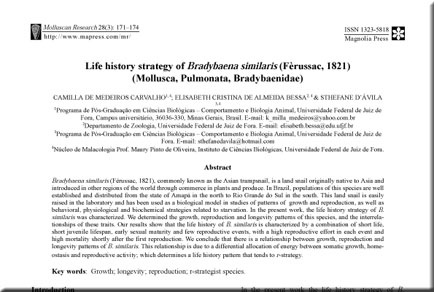Abstract
Bradybaena similaris (Férussac, 1821), commonly known as the Asian trampsnail, is a land snail originally native to Asia and introduced in other regions of the world through commerce in plants and produce. In Brazil, populations of this species are well established and distributed from the state of Amapá in the north to Rio Grande do Sul in the south. This land snail is easily raised in the laboratory and has been used as a biological model in studies of patterns of growth and reproduction, as well as behavioral, physiological and biochemical strategies related to starvation. In the present work, the life history strategy of B. similaris was characterized. We determined the growth, reproduction and longevity patterns of this species, and the interrelationships of these traits. Our results show that the life history of B. similaris is characterized by a combination of short life, short juvenile lifespan, early sexual maturity and few reproductive events, with a high reproductive effort in each event and high mortality shortly after the first reproduction. We conclude that there is a relationship between growth, reproduction and longevity patterns of B. similaris. This relationship is due to a differential allocation of energy between somatic growth, homeostasis and reproductive activity; which determines a life history pattern that tends to r-strategy.

